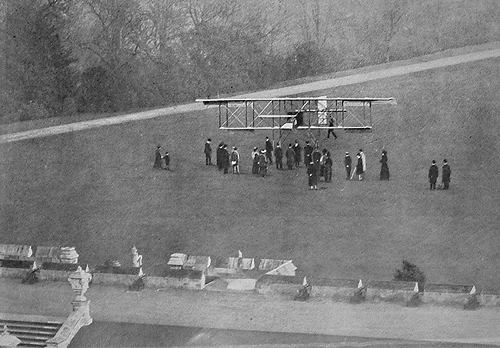The First Aircraft
over Windsor
1911 and Tommy
Sopwith lands at Windsor Castle
as George V watches with his family
 Tommy Sopwith lands at Windsor
Castle, on the lawns by the East Terrace.
Tommy Sopwith lands at Windsor
Castle, on the lawns by the East Terrace.
For 95 years, since February 1st 1911,
aircraft have been flying over Windsor Castle. February 2006
sees the 95th anniversary of the first flight by Tommy Sopwith
when he flew his aeroplane from Brooklands to Windsor. Little
could he imagine that less than 70 years later Brooklands would
play a major part in the construction of the supersonic Concorde
passenger plane which was to fly over the castle several times
a day from 1976 to 2003 and even less could he have imagined
that 100 years on, Brooklands would have on display Delta Golf,
one of the development Concordes.
Thomas 'Tommy' Sopwith (1888-1989) was interested in both motor racing
and flight. He taught himself to fly in a Howard Wright monoplane
that he bought in 1910, gaining his licence in November that
year at Brooklands. Shortly thereafter he won the £4,000
Baron de Forest Prize for his flight from England to Beaumont
in Belgium, a distance of 169 miles (272 km) on 18 December 1910.
In the picture above he has flown an aircraft from
Brooklands to Windsor, a distance of just 10 miles, at the request
of King George V. The date was Wednesday February 1st 1911 and
is believed to be the first flight of any aircraft to the castle
or Windsor. Arthur Goddard, in his book 'Windsor: The Castle of Kings' writes:
On Wednesday, February
1st of the current year, Windsor was the scene of an interesting
incident which illustrated in very practical fashion the progress
which has been made in the world of invention since William of
Normandy built his fortress on the great hill above the Thames.
A young aviator, Mr. Tom Sopwith, winner of a £4,000 prize
for the longest British flight on a British machine, flew from
Brooklands to Windsor, where he alighted, with the grace of a
bird, after circling with the greatest ease above the trees in
the Home Park and the towers of the Castle itself, finally descending
upon a spot close to where, upon the East Terrace, stood King
George V and his children. The aviator was presented to the King,
who congratulated him upon his successful flight, and then, with
his children, carefully examined the aeroplane, in which His
Majesty showed keen interest.
When it is remembered that the practice of aviation
has already passed far beyond the primitive stage when it was
regarded as merely something more or less in the nature of a
freak pastime, and that as a science it has made exceptional
strides even during the past few months, it seems fitting that
King George should have shown himself sympathetically inclined
towards it at so early a period of his reign. In the nineteenth
century, it is true, the problem of flight was discussed seriously
in the world of science, but scarcely regarded so by the public
generally, and wits of the period poked fun at it with pen and
pencil, George Cruikshank and others finding in the subject a
fertile field in which to cultivate their sense of humour. But
the aeronautics with which they dealt and at which they laughed,
were chiefly concerned with balloons, ballooning, and what was
not infrequently dubbed balloonacy. The day of dirigibles had
not then arrived, while aeroplanes had not entered at all into
the scheme of practical mechanics. In those days a motor-car,
as we know it now, would have been a revelation, and the navigation
of the impalpable air, as it is understood and accomplished to-day,
would have seemed neither more nor less than a fantastic dream.
It is inevitable that some of the most notable manifestations
and developments of aeronautical science will, in days to come,
not only be definitely and instinctively associated with the
present reign, but that the name of King George will be indissolubly
linked to the earliest examples of it, for the Aerial Post to
Windsor fired the imagination of millions, and was of peculiar
interest to all who indulge in mental glances into the future.
The Sopwith flight from Brooklands to Windsor, and
the reception of the aviator by King George, cannot fail to find
a place in the history of aeronautics.
Around eight months later, in September
1911, Gustav Hamel would be the first to fly 'Aerial Post' from
Hendon to Windsor. Aerial Post
See also

To contact us, email
Thamesweb.
|

